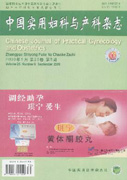Abstract: Objective To investigate the ovarian function of the patients receiving postoperative radiotherapy or chemotherapy after ovarian suspension in cervical squamous carcinoma.Methods Collect 308 cases of cervical squamous cell carcinoma in stage ⅠA~ⅡA patients who underwent radical hysterectomy and pelvic lymph node dissection and ovarian suspension surgery. Divide them into different groups according to the age, the quantity of ovarian suspension (unilateral and bilateral) or whether receiving postoperative adjuvant therapy (chemotherapy,adjuvant radiotherapy, chemotherapy+adjuvant radiotherapy) or not. The modified Kupperman Index was used to investigate the ovarian function of the patients in the following six months after the operation. Results According to the difference of the quantity of ovarian suspension or the age, modified Kupperman score had no statistical significance (P>0.05). Comparing the Group operation + radiotherapy with Group operation,Group operation + radiotherapy + chemotherapy with Group operation, Group operation + radiotherapy with Group operation + chemotherapy ,all the modified Kupperman scores had statistically significant (P<0.05). Comparing the Group operation + chemotherapy with Group operation, Group operation + chemotherapy with Group operation + radiotherapy + chemotherapy,Group operation + radiotherapy with Group operation + radiotherapy + chemotherapy,all the modified Kupperman scores showed no significant difference (P>0.05).Conclusions Postoperative radiotherapy or chemotherapy may affect the endocrine function of ovaries in patients receiving ovarian suspension.The ovarian function may have nothing to do with the age or the quantity of the ovaries.

